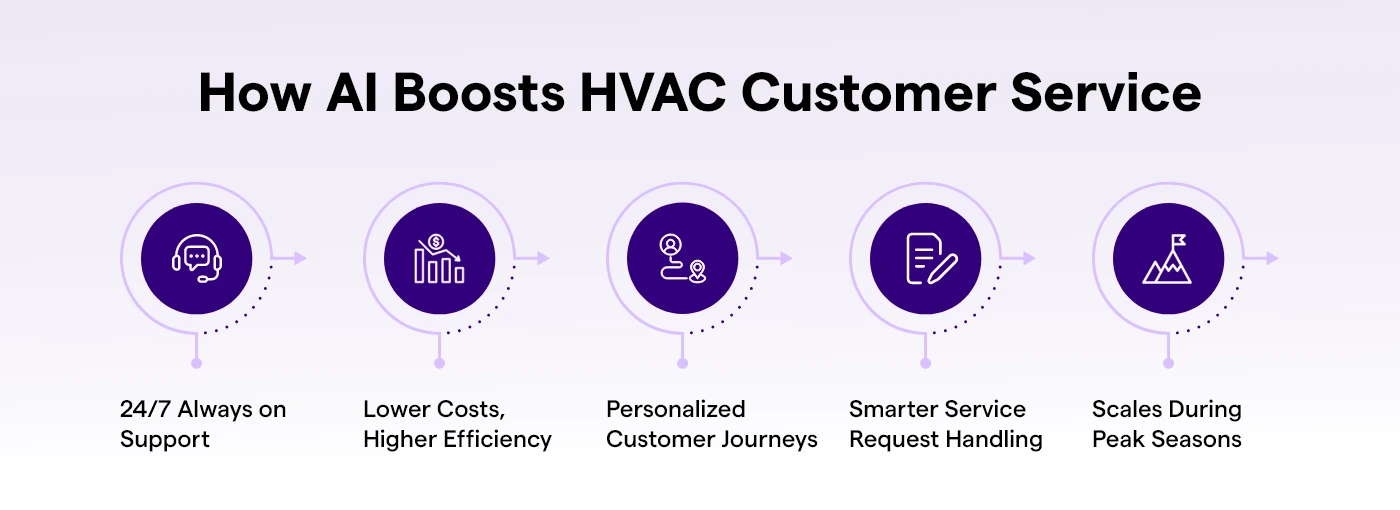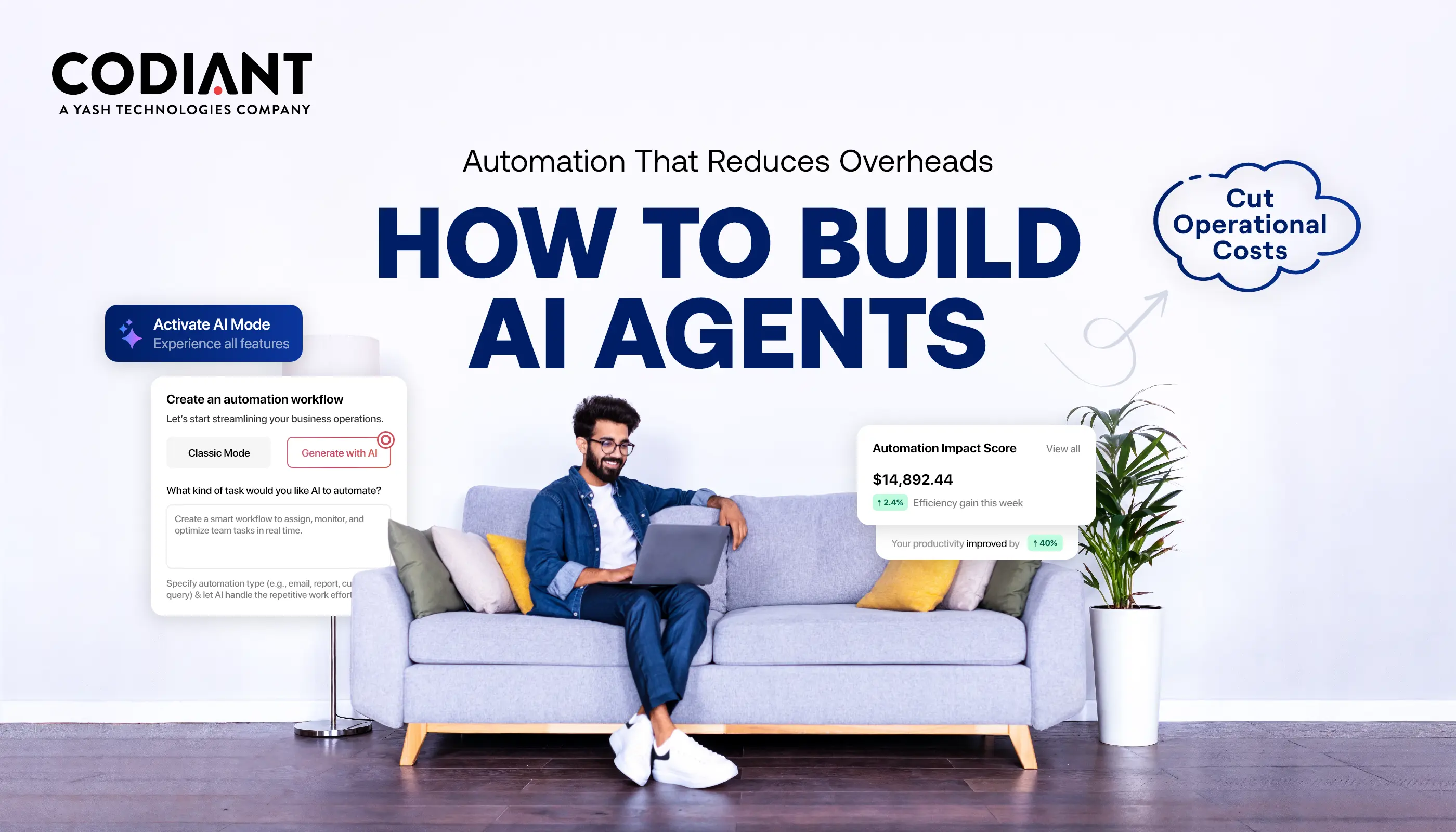How HVAC Companies in USA Use Chatbots and AI to Improve Customer Service?
Table of Contents
Subscribe To Our Newsletter

Key Takeaways:
- AI is no longer optional for HVAC – in 2025, over 70% of U.S. contractors have tested AI, and about 40% use it regularly.
- Chatbots improve response times by handling service requests instantly, reducing missed leads, and cutting call centre overload during seasonal peaks.
- Predictive maintenance powered by AI prevents breakdowns, lowers emergency calls, reduces repair costs, and extends equipment life.
- Smarter service request management automates logging, prioritization, dispatch, and customer updates-making HVAC companies look proactive instead of reactive.
- Real-world adoption is growing – from 24/7 chatbot support to AI-driven dispatch and upselling, HVAC businesses are already seeing tangible ROI.
- Challenges exist (integration, costs, training, customer adoption), but early adopters are gaining a competitive edge in customer loyalty and efficiency.
- Bottom line: AI won’t replace HVAC technicians, but it will define which companies stay competitive by delivering faster, smarter customer service.
Air conditioners don’t break at convenient times. They die on the hottest day of the year, right when every HVAC company’s phone lines are jammed. And customers? They don’t want to wait 45 minutes just to hear “we’ll call you back.” Honestly, that is worse than no answer at all.
This is why AI for HVAC customer service and home service apps is moving from “interesting idea” to “absolute necessity.” Across the U.S., heating and cooling companies are sliding chatbots, virtual assistants & predictive systems into their customer pipelines. Not as tricks, but as real fixes for slow response times, scheduling nightmares and frustrated homeowners.
You can think of it like this- your thermostat got smart years ago, but your service line stayed stuck in the 90s. AI is the bridge that finally connects the two.
Why HVAC Companies Need AI for Customer Service?
HVAC has always been about the hardware – compressors, ducts, coils. But ask any homeowner what they actually remember after a service call & it’s rarely the technical details. It’s how fast someone picked up the phone. It’s whether they got a straight answer or felt like they were being bounced between departments.
Customers now expect the same service speed from HVAC that they get from Amazon or Uber. A few taps, instant confirmation, zero friction.
And when they don’t get it? They’re gone, probably tweeting about how your competitor showed up first.
This is where AI solutions for heating & cooling service quietly shifts from optional add-on to survival tool. Chatbots don’t go on lunch breaks.
Predictive systems don’t forget to follow up. And unlike human staff crushed under seasonal spikes, AI doesn’t panic when 200 people suddenly need their AC fixed on the same scorching afternoon.
Customer service has become the real battleground for HVAC companies – not the equipment, not the price point, but the experience. And AI is arming the ones who want to win it.
How AI Chatbots Help HVAC Businesses Improve Customer Service?
For HVAC companies, customer service often breaks down at the simplest point- answering questions quickly. Call centers get overwhelmed, response times stretch & customers feel ignored. That’s where chatbots are making a measurable impact.
AI chatbots for HVAC businesses are not just generic helpdesk tools. They can capture service requests in real time, schedule appointments, guide homeowners through basic troubleshooting and filter urgent issues from routine ones. Instead of a customer waiting on hold, they get an instant response that actually moves the process forward.
The benefits stack up quickly. Companies reduce missed leads. Customers avoid the frustration of endless transfers.
And because these systems learn from each interaction, they adapt to common patterns – spotting issues like seasonal spikes in AC repairs and routing requests more efficiently.
It’s less about replacing human staff and more about building a first line of support that never switches off.
Put AI Chatbots to Work in Your HVAC Business
Automate inquiries, capture leads, and deliver 24/7 support with AI chatbots tailored for HVAC companies.
Top Benefits of AI for HVAC Companies

AI in HVAC isn’t about new technology-it’s about fixing very real bottlenecks that cost businesses time, money & customers. Here’s where the impact shows up most-
-
Round-the-clock availability
AI tools handle customer inquiries at any hour. That means a broken furnace at midnight doesn’t sit unattended until morning. For homeowners, that’s peace of mind. For companies, it is one less lost lead.
-
Reduced operating overhead
Traditional call centers scale poorly. During peak seasons, businesses either overstaff or miss calls. AI absorbs repetitive tasks-service logging, appointment scheduling, FAQ responses-so human staff are freed up for complex issues.
-
More personalized interactions
AI doesn’t treat every customer the same. It remembers past service history, anticipates seasonal needs & delivers suggestions that feel useful instead of generic. That kind of relevance builds trust.
-
Faster service request management
Requests don’t just get noted. They’re categorized, prioritized and routed to the right technician immediately. The result- shorter wait times and fewer cases falling through the cracks.
-
Scalability under pressure
When a heatwave or cold snap floods lines with calls, AI keeps pace without error. Customers still get quick responses instead of endless hold times.
These benefits make a real difference. Customers stay happier, companies close more jobs & people are more likely to call again. In HVAC, where reputation drives repeat business, that’s a serious advantage.
How AI Enables Predictive Maintenance in HVAC?
Breakdowns don’t follow business hours. A furnace that stops in the middle of winter or an AC unit that dies in peak summer creates panic for customers and pressure for HVAC companies. Predictive maintenance in HVAC with AI turns that scenario around by identifying problems before they turn into emergencies.
Here’s where the impact shows up-
-
Early fault detection
AI monitors performance data-like temperature shifts, vibration or energy spikes-to catch irregularities well before they cause failure.
-
Reduced emergency calls
By spotting issues early, companies cut down on last-minute breakdowns and after-hours service requests.
-
Extended equipment lifespan
Addressing minor problems on time keeps systems running efficiently for longer, reducing costly replacements.
-
Lower repair costs
Preventive action often means fixing small faults instead of paying for major part replacements.
-
Smarter resource planning
AI insights help plan technician schedules and parts inventory, avoiding unnecessary delays during busy seasons.
Predictive maintenance powered by AI isn’t just about technology-it’s about shifting HVAC companies from reactive problem-solvers to proactive service partners. Customers notice that difference & it builds trust.
Read more: How an On-Demand Home Services App Increased Bookings by 40%
How AI Improves HVAC Service Request Management
One of the biggest headaches for HVAC companies is not just the repair itself-it’s managing the flood of service requests. Calls pile up, tickets get misplaced and customers feel left in the dark. AI solves this by streamlining how requests are captured, organized & assigned.
Here’s what that looks like in practice-
Automated request logging – AI systems record every service request instantly, ensuring no inquiry slips through the cracks.
Smart categorization – Requests are tagged by issue type-heating, cooling, maintenance or emergency-so they’re easier to prioritize.
Faster technician dispatch – AI matches jobs with available technicians based on location, skill set & urgency, cutting down wait times.
Real-time updates for customers – Homeowners can receive automated notifications about technician arrival times or delays, reducing frustration & guesswork.
Performance insights – Over time, AI highlights recurring issues or bottlenecks in request handling, giving managers the data to improve operations.
For HVAC companies, this means smoother workflows & fewer angry follow-up calls. For customers, it feels like the company is one step ahead instead of one step behind.
Real-World Examples of AI in the HVAC Industry
The theory sounds good, but what does it look like when HVAC companies in the U.S. actually put AI to work? The results are noticeable. From small local providers to nationwide service chains, many are already seeing tangible improvements in how customers experience their brand.
Some examples of how it’s playing out-
-
24/7 chat support
Regional HVAC firms are deploying AI chatbots on their websites and mobile apps. Customers can book appointments, troubleshoot minor issues & get answers to pricing questions – even outside office hours.
-
Predictive maintenance pilots
Larger U.S. providers are experimenting with AI-driven maintenance programs. Sensors feed performance data into AI systems, which flag potential equipment failures before they happen. That cuts emergency calls and improves trust.
-
Smarter dispatch systems
Several service companies have layered AI into their scheduling tools. Instead of a dispatcher juggling calls manually, the system assigns technicians based on availability, skill set & travel distance. Customers get quicker service & technicians waste less time in traffic.
-
Upselling with context
AI chatbots don’t just answer questions – they also recommend seasonal tune-ups, filter replacements or warranty extensions when the timing makes sense. It feels less like sales pressure and more like timely advice.
Challenges of Using AI in the HVAC Industry
AI is not a plug-and-play switch. For HVAC companies, moving from manual systems to AI-driven operations comes with hurdles that need to be addressed early. Ignoring them usually leads to wasted investments or frustrated staff.
Here are the most common challenges – and how companies are tackling them-
-
Integration with legacy systems
Most HVAC companies already use scheduling or billing software. AI tools need to connect smoothly with these systems. Without proper integration, data stays siloed & the benefits shrink.
-
Upfront costs
AI solutions require investment in software, sensors & sometimes infrastructure upgrades. Companies that succeed usually start small – testing chatbots or predictive tools in one service line – before scaling across operations.
-
Staff training
Employees may resist AI if they see it as a threat. The fix is clear communication- AI is there to handle repetitive tasks, not replace skilled technicians. Training staff to work alongside these tools builds confidence.
-
Customer adoption
Not all customers are comfortable with bots. Offering a clear path to human support ensures AI adds convenience without alienating people who prefer talking to a person.
-
Data management
AI is only as good as the data it uses. Inconsistent service records or missing maintenance histories reduce accuracy. Companies that standardize data collection see stronger results.
How AI is Transforming HVAC Customer Service in 2025?
The future of AI in HVAC customer service is shifting fast. By 2025, more than 70% of U.S. contractors have tested AI tools & about 40% now use them regularly. What was once experimental is quickly becoming standard.
AI app development is making support proactive rather than reactive. Instead of waiting for breakdowns, systems can predict problems, send alerts & even schedule checkups before issues escalate.
Voice-based systems are also on the rise. They let customers explain problems naturally and get guided troubleshooting – especially helpful when stress levels run high during an AC failure.
AI won’t replace humans. It will take care of routine questions or routing, while technicians handle complex cases. This teamwork reduces waiting times but preserves personal service.
Smarter suggestions are another benefit. For example, AI can flag recurring summer struggles and recommend a filter change or preventive inspection, boosting both customer trust and company loyalty.
Finally, AI is driving energy efficiency. Studies in 2025 show smart building systems with AI deliver 10–20% energy savings, with some pilots reporting even higher. Combined with sustainability gains, this makes AI an essential part of HVAC’s future.
Real Also: Insurers Claims Management With AI
In Summary
Customer service in HVAC has always been the weak spot. Long waits, missed calls & reactive fixes have frustrated homeowners for decades.
What’s changing in 2025 is that AI, powered by advanced machine learning technology, is no longer just theory, it’s being used daily to smooth service requests, predict breakdowns, and keep lines open when human staff can’t.
The benefits are practical-faster response times, lower costs, fewer emergencies, and more loyal customers. The tools-chatbots, predictive systems, automated dispatch — are already proving their value in the U.S. market. And as a leading AI Development Company in USA, we’ve seen that adoption numbers don’t lie — companies that move early are pulling ahead.
The bigger picture? AI won’t replace technicians, but it will decide which HVAC businesses stay competitive. Those that embrace it will build trust, efficiency and resilience. Those that don’t will keep losing customers to companies that can respond in seconds instead of hours.
For HVAC leaders, the question isn’t if AI fits into customer service. It’s how fast you can put it to work.
Future-Proof Your HVAC Business Today
Implement AI-apps that optimize service requests, predict failures, and strengthen long-term customer loyalty.
Frequently Asked Questions
Yes. Today’s AI chatbots can do common jobs like booking service calls, answering simple questions &recording problems. They may not be perfect, but when they work with human staff, they make replies faster and stop companies from missing new customers.
The price depends on what you want. A basic chatbot on your website is not too costly. But if you want smart systems that use sensors to predict problems, that will cost more. Many HVAC companies first start small with chatbots or auto-scheduling, then grow later.
No. AI can’t fix a broken AC unit or climb on rooftops. What it does is help with tasks like scheduling, finding problems early &doing paperwork. The real repair work still needs human technicians. AI is a helper, not a replacement.
AI needs information from HVAC machines, like temperature, vibration, energy use &airflow. If a company has smart thermostats or sensors, the data is already there. Without good data, AI can’t predict problems well.
It depends on how it’s set up. If the AI gives fast, helpful answers, people like it. But if it feels like they’re stuck talking to a robot with no way to reach a human, they get upset. The best systems always let people switch to a human agent when needed.
Featured Blogs
Read our thoughts and insights on the latest tech and business trends
Learn How to Build AI Agents That Can Speed Up Your Work and Reduce Other Expenses
- November 10, 2025
- Artificial Intelligence
Businesses today are looking for faster ways to work and smarter tools that cut costs. That’s why AI agents are quickly becoming a key investment for companies of all sizes. These autonomous systems can perform... Read more
How to Build a Logistics and Transportation App Like Aramex?
- November 6, 2025
- Logistics & Transportation
In a Nutshell: A logistics app like Aramex helps businesses manage deliveries, track shipments, and serve customers better. Technology is now needed in logistics because customers want fast delivery and real-time tracking. A logistics app... Read more
How to Modernize Legacy Systems with AI – A Step-by-Step Guide
- October 31, 2025
- Artificial Intelligence
In a Nutshell: Legacy systems aren’t outdated - they’re underutilized. AI can modernize them without full replacement, saving time and cost. Modernization is a journey, not a rebuild. Start small with automation, data clean-up &... Read more





